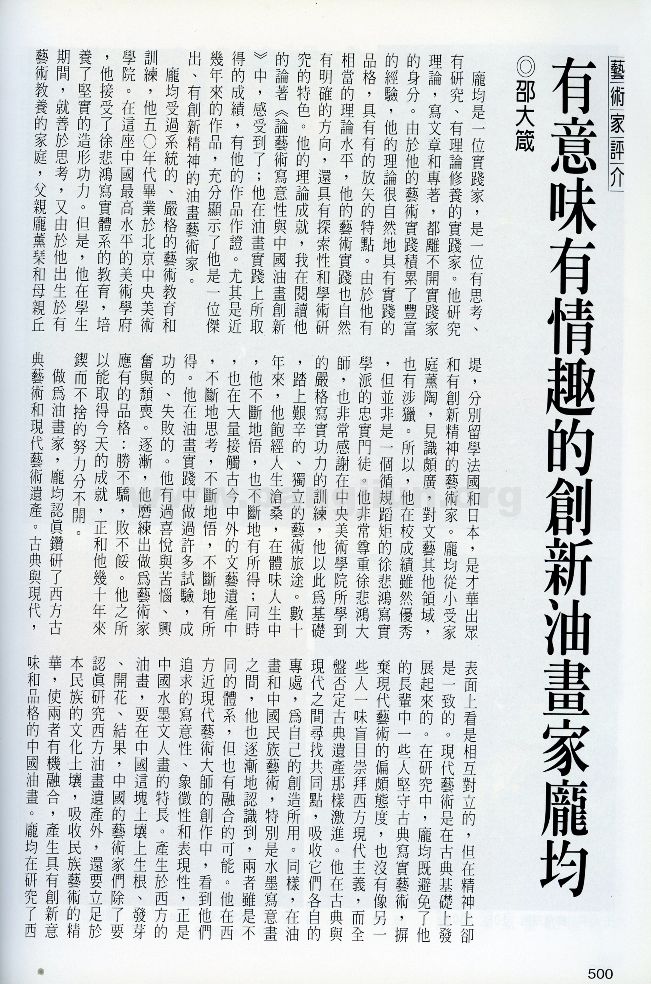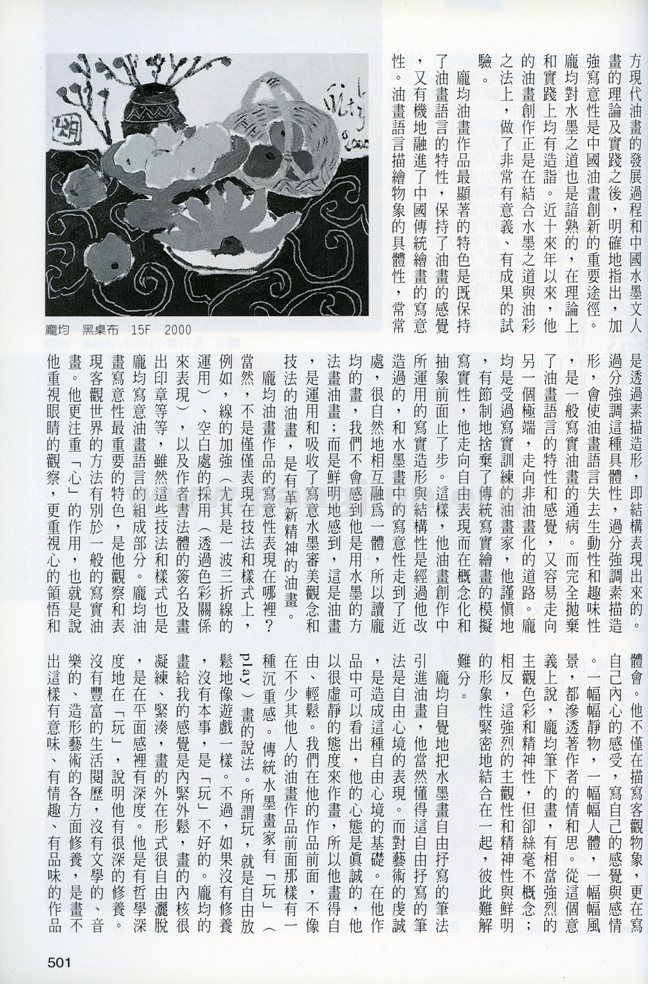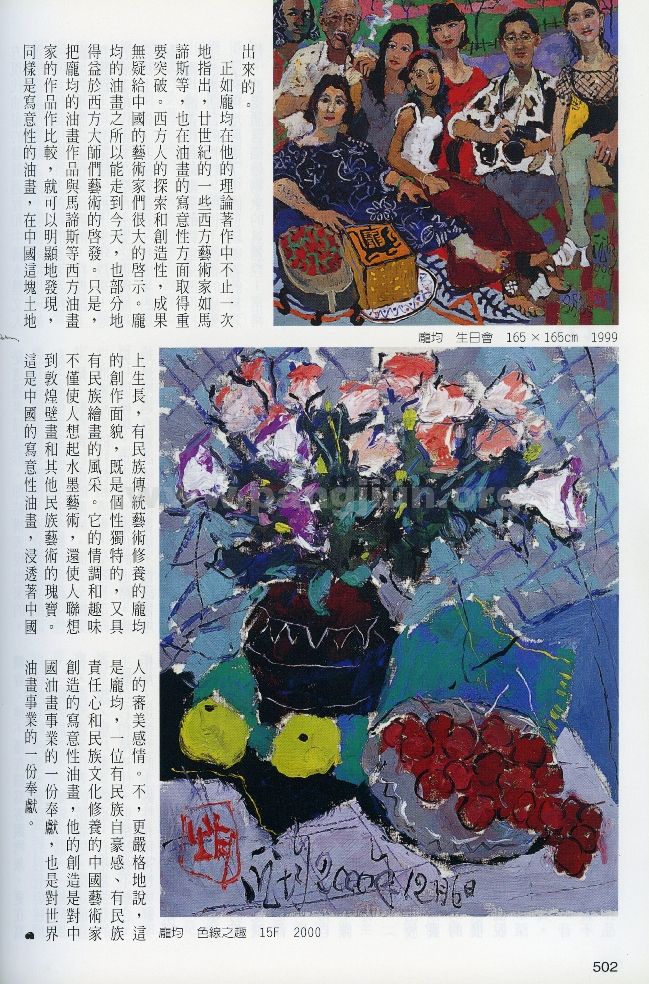 CLOSE
CLOSE
PANG is an executor with full of thoughts, researches, and theories. He has been living as an executor no matter he studies theories or writes articles and books. Due to his rich experiences of art practice, his theory naturally involves realistic characters and meaningful debates. Based on serious research, his art practice naturally points to a clear direction, which allows him to explore and examine art theories. Through his book, Debating on the Idealism of Art and the Creativity of Chinese Oil-Painting, his achievement in the research of art theory can be easily seen. As for his achievement in his oil-painting practice, it is well proved by his fine works, particularly the ones having been made in recent years, which find him a remarkable oil painter with a great sense of creativity.
PANG graduated from Central Academy of Fine Arts, Beijing in the 1950s and had been educated systematically and trained seriously. Studying in the most qualified art academy with the highest reputation in China, he grew his strong ability of formation under the education of Bei-Hong HSU’s Realism Art. He exceeded in thinking as a student during this period of time. Besides, he was born in a family with the capability of art; i.e., his father Xunqin PANG and mother Ti CHIU separately studied art in France and Japan and they were both remarkable creative artists. J. PANG was brought up in such a family; as a result, he has had wide views on different things, not just on art, but also on other fields such as literature. He was a brilliant student at school but not actually a loyal adherent of Bei-Hong HSU’s Realism Art. He greatly respected and counted on HSU as well as appreciated the tough training he received in Central Academy of Fine Arts, Beijing. He grew from that and stepped onto his own tough and lonely art journey. For all these years he has experienced the bitter of life. In tasting life, he has been awakened and has been given. Simultaneously, from a great amount of heritage of art and literature from ancient and modern times and from China and foreign countries, he has never stopped thinking, being awakened and inspired, and taking and getting. He has experimented different art practices no matter whether it was a success or a failure. He has tasted joy and misery, excitement and distress. Thus little by little, he has formed himself the character of an artist, neither elated by success nor discouraged by failure. The reason why he can be where he is today is due to the endeavours he has been making in his life.
As an oil painter, J. PANG has seriously studied the heritage of Western Classicism and Modernism. In general, classical and modern seem like two contradictory ideas but actually on a spiritual level, there is no confrontation between these two; i.e., Modernism established on the basis of Classicism. The research tells that J. PANG, on the one hand, prevented himself from his seniors’ partial attitude of insisting on Realism Art and of turning down Modern Art; on the other hand, he was not so aggressive as the other artists to blindly worship Western Modernism and completely denied ancient heritage of the East. Instead, he tried to dig something between Classicism and Modernism in common and absorbed their individual uniqueness to involve in his own creation. Similarly, he gradually realised oil-painting and Chinese Art, particularly ink-painting, could also possibly integrate, despite that they belonged to different art systems. From Western modern masterpieces, he found the artists pursuing the sense of idealism, symbolism, and expressionism, which was exactly the strongest point of Chinese Ink-Painting. As far as he was concerned, oil-painting which was sowed in the West would have rooted, sprouted, blossomed, and bore fruit in the Eastern fields only if Chinese artists could not only have seriously grown Western oil-painting, but have tried to make it live long in the Eastern fields. Then Chinese artists should also consume the merits of Chinese Art, and make the two integrate into the Chinese Oil-Painting with creativity and character. J. PANG clearly indicated that the reinforcement of the idealism of Chinese Oil-Painting would be a very important way to create new Chinese Oil-Painting after his studies in the development of Western modern oil-painting and the theory and practice of Chinese Ink-Painting. Besides, J. PANG was also very familiar with the method as well as the spirit of Ink-Painting both theoretically and practically. Amongst the nearest decade, he has meaningfully experimented the integration of the methods of ink-painting and oil-painting in his own oil-painting and received meaningful and successful result.
The most remarkable characteristic of J. PANG’s oil-painting is that he not only retains the character, language and impression of Western oil-painting, but also actively adds the impression of Chinese traditional painting. Oil-painting often speaks aloud the realistic and the concrete of objects through sketches, formation and construction. However, too much emphasis on the realistic and the concrete, and on the formation of the sketch, will outgrow the liveliness and fun of oil-painting, which is the common issue of realistic oil-painting. Nevertheless, thoroughly throwing away the character and sense of oil painting will instead lead to the other very end, the farewell of oil-painting. As a result, being a well-trained oil painter with Realism, J. PANG carefully and conditionally removed the simulation of traditional Realistic painting, and dressed the free expression, which was hopefully stopped before his expression turned into conceptualisation and abstraction. Furthermore, the realistic formation and construction in his oil-painting has been re-constructed, which naturally integrates with the impression of ink-painting into one. Reading his painting, we will not feel that he paints with the method of ink-painting, but clearly feel that it is indeed creative oil-painting, which employs the method of ink-painting and absorbs the sense of the appreciation of the beautiful of ink-painting, i.e., the oil-painting of innovation.
Nonetheless, how can J. PANG’s idealistic expression in his oil-painting be revealed? Of course, this is not only presented in the patterns and skills, e.g., the improvement of lines, the employment of space, the calligraphy-like signature and the appearance of a seal, even though J. PANG’s ideal oil-painting also comprises these skills and patterns. The most essential characteristic of J. PANG’s ideal oil-painting exists in the way he observes and expresses the objective world, which differs from the ordinary realistic oil-painting. He pays much attention to the effect of ‘mind’; i.e., he takes the observation of his eyes seriously, but takes that of his mind more seriously. Not only does he portray objective objects, but also depict the sense and feeling on his mind. Still lives, portraits, scenery, and the like embody the artist’s feelings and thoughts. That is, J. PANG’s painting includes very strong subjective colour and spirit, but is not at all conceptual; by contrast, this strong subjectivity and spirit rather combine with the clear image so closely as not to separate.
PANG self-consciously employs the free strokes of ink-painting as he senses that this comes from the expression of the artist’s free will. This will is based on the artist’s sincere attitude towards art. From his work, it could be seen that he was rather sincere and painted with sincere attitude so that he painted freely and easily. In front of his work, the audience does not feel as heavy as in front of many others’. Traditional ink painters ‘play’ with painting, which means painters paint as freely as playing games. However, without real skills, sense and knowledge, it shall not be fun to ‘play’. J. PANG’s painting feels tight inside and loose outside; i.e., from inside, the painting is concentrated and well-organised, and outside, it is out of limitation and boundary. His painting finds the depth in a plane form. He ‘plays’ philosophically and deeply, which affirms his possession of the profound knowledge. Without abundant life experiences and without any knowledge of literature, music and plastic art, the artist will not be able to create such a fine work, which is full of flavour, interest and taste.
Just as what J. PANG has pointed out in his theory over again, Western artist in the 20 century such as Henri Matisse also reached certain achievement in the ideality of oil-painting. And Westerners’ exploration on art and their creative harvest undoubtedly inspired Chinese artists. So, partly thanks to the inspiration from Western masters, J. PANG’s art can last till now. However as compared to Western artists’ works, e.g., Matisse’s work, it is obviously seen that J. PANG’s creation growing on the field of China contains not only the unique characteristics of its own but also the elegance of folk paintings. Its taste and interest does not only remind the audiences of ink-painting but also of the mural painting in Dun-Huang and other races’ finest works. This is Chinese ideal oil-painting, absorbing the feelings and the appreciation of the beautiful. More seriously speaking, this is the ideal oil-painting of J. PANG, a Chinese artist who respects the family feelings, the responsibility and the profound knowledge of the nation and its culture. This is also his contribution to the Chinese and the world’s oil-painting.


